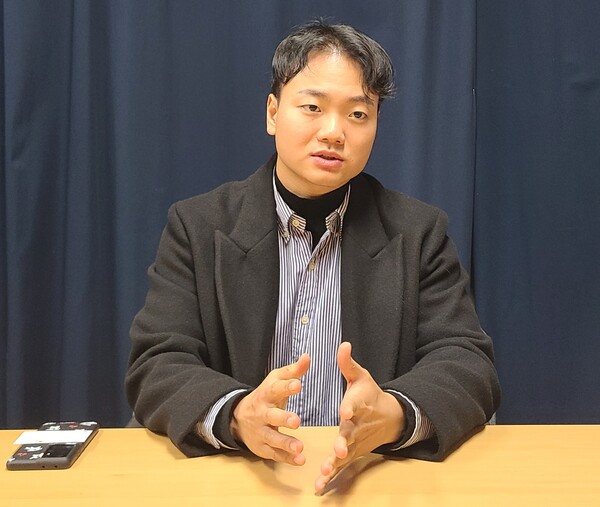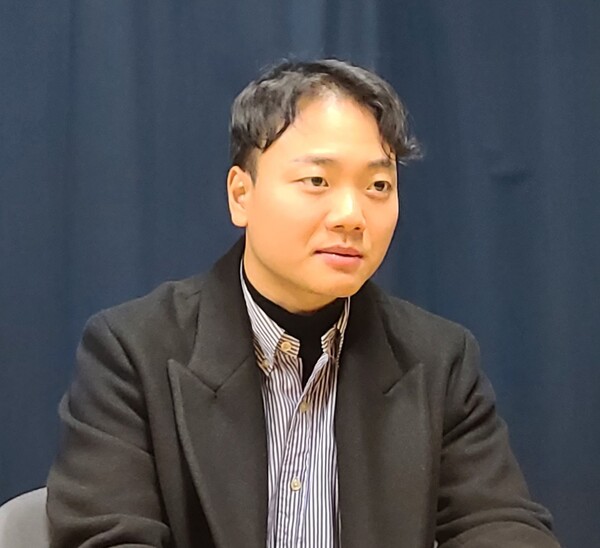Narcolepsy is a rare and much-misunderstood disease with an estimated prevalence of 15 per 100,000 Koreans. It's a "brain disease" caused by a lack of hypocretin, a wakefulness hormone secreted by the brain, but most people are not aware of it. There is also a common misconception that narcolepsy must accompany cataplexy, the sudden loss of strength and collapse, although the latter does not occurs in all narcolepsy sufferers.
In narcolepsy patients, cataplexy can occur in the form of full-body muscle weakness, as is often portrayed in the media, including soap operas. However, it can occur more commonly in just a few muscles, including the jaw, shoulders, knees, and arms, which is poorly understood. There is also a type of narcolepsy that accompanies "no cataplexy.” Narcolepsy is categorized as type 1 when there are cataplexy attacks and type 2 when there are no cataplexy attacks, with a 7:3 ratio of type 1 to type 2 narcolepsy.
Lee Seung-jae, 30, a narcolepsy sufferer who joined the Korean Narcolepsy Patients Association last year, said that his type 2 narcolepsy started when he was in high school. He had been experiencing sleep attacks by falling asleep without trying. However, because Lee didn't have any cataplexy, he misunderstood that it wasn't narcolepsy. It wasn't until May 2023, more than 10 years after the onset, that he was properly diagnosed.

Of course, he had plenty of reasons to suspect narcolepsy early on. There were the warlike mornings when he had to be woken up for more than an hour every morning just to get out of a deep sleep to go to school and the times when he would have sleep attacks without warning, earning him the nickname "Sleeping Beauty" at school. There were also the days when a lack of caffeine would make him fall asleep even more, leading him to drink coffee like it was his "water of life.”
"When I was a high school senior, my symptoms became more severe as I reduced my sleep time. One day, I had a blackout on my way to a bus stop, and I had no memory of how I got about 50 meters. When I suddenly woke up, a car passed before me, and I barely escaped big trouble," Lee recalled. "I was surprised and suspected narcolepsy, so I looked it up. However, I thought it wasn't narcolepsy because the material said that you must have a cataplexy to have narcolepsy."
Lee said he had been suffering from Excessive Daytime Sleepiness (EDS), a condition that makes you feel very sleepy during the day even if you get enough sleep at night, and Brain Fog, a condition where your brain is foggy due to excessive work and an irregular lifestyle that leads to overwork and freelancing. However, he was stuck in the belief that you have to have an exhaustion attack to have narcolepsy, so he didn't even suspect it.
A turnaround came in May last year. He quit the job in January 2023 to take a break from work but he continued to feel low, with no improvement in his brain fog symptoms. Then, Lee’s friend advised him to visit a sleep center for treatment. Thinking that his symptoms were caused by snoring and sleep apnea, he went to the sleep center for a prescription for a positive airway pressure machine. After two tests, however, he was diagnosed with narcolepsy.
"The first test showed narcolepsy, but I was so tired on the day of the test that I thought it was a false result, so I paid another 1.5 million won ($1,122) for a retest. However, the test result was the same as the first test," he said.
Lee had blamed himself for his sleep attacks, thinking it was a matter of mental strength and being accused of being “lazy” by his closest family members, all because of a lack of wakefulness hormones in his brain.
A diagnosis of narcolepsy, a rare brain disorder, has changed his life forever. While about 95 percent of rare diseases have no cure, narcolepsy patients are relatively fortunate because there are treatments for the mechanism that stimulates the central nervous system to prevent drowsiness. With lifestyle modifications, nine out of 10 patients can live with controlled symptoms, and Lee fell into that category. The brain fog that had always plagued him also cleared up the day he started taking Modafinil, a narcolepsy medication.
"Within an hour of taking the medication, my head felt very clear, like sunlight was shining in my head," Lee recalled. "Now, in addition to taking medication, I have a routine where I go to bed around midnight and wake up exactly at 7:30 a.m. to control my symptoms, and I manage my disease by informing people around me about narcolepsy and asking for their help and understanding when I have symptoms."
Many people with narcolepsy remain undiagnosed although they can control their symptoms if they were diagnosed like Lee. Although the number of narcolepsy patients in Korea is estimated to be around 7,500, the diagnosis rate of narcolepsy is low, with only about 4,200 registered as narcolepsy in 2019, or 8.4 per 100,000 people (according to data from the Korean Neurological Association). This means that about 40 percent of narcolepsy patients have failed to find a proper name for their disease.
"Compared to other countries, I know that the diagnosis rate of narcolepsy is uniquely low in Korea," Lee said. "I hope that social awareness campaigns will be carried out so that people with narcolepsy can find out their diagnosis early and live a happier life through treatment by, for instance, visiting a nearby sleep center or neurology department when they have sleep disorders such as cataplexy and sleep paralysis."

There are other misconceptions about narcolepsy. While it is true that people with narcolepsy have a higher risk of developing mental illnesses, such as depression, than healthy people, not all people with narcolepsy develop psychiatric symptoms. In addition, about 10 percent of narcolepsy sufferers have uncontrollable daytime hypersomnia and cataplexy, even with medication and lifestyle changes, and some patients cannot leave their homes at all. However, the diagnosis of narcolepsy is currently limited to “mental illness disorder,” which is only possible when there are psychiatric symptoms.
"There are patients with narcolepsy type 1 who do not have psychotic symptoms. Even if they take medication, they cannot leave the house because of a sudden collapse event on the road," Lee noted. “I think that because we don't know enough about narcolepsy, we only allow people to be diagnosed with a disability when they have mental symptoms."
Lee then reiterated his call for improving the diagnostic criteria for narcolepsy disability.
The treatment and management environment for narcolepsy in Korea has changed significantly since the voices of narcolepsy sufferers changed their perception of the disease. In 2007, a narcolepsy patient founded the Korea Narcolepsy Patients Association on Naver Cafe, and based on that, patients gathered to petition the National Assembly, the Ministry of Health and Welfare, and the Ministry of Defense. In 2009, narcolepsy was designated as a rare disease, and in 2010, it became a disease that can be exempted from military service.
For this reason, Lee believes that problems like the low diagnosis rate of narcolepsy can be solved through activities to improve social awareness of the disease. He has already seen the potential through patients' work, who write about narcolepsy on Kakao's blog, “Brunch Story.” As a marketer, he is also exploring the possibility of running social campaigns with other marketer organizations that help the underprivileged.
"In narcolepsy, it is very important to be diagnosed and treated accordingly, but there is still a lack of information. In rural areas, access to treatment is even lower. It's difficult to get consideration when having a narcolepsy attack outside of your home, and you may even be 'bullied' at work," Lee said. "There is always a gap between the ideal and the reality, but I hope our society will find ways to make it work within reason."

